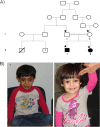LINS, a modulator of the WNT signaling pathway, is involved in human cognition
- PMID: 23773660
- PMCID: PMC3847167
- DOI: 10.1186/1750-1172-8-87
LINS, a modulator of the WNT signaling pathway, is involved in human cognition
Abstract
Background: Inherited intellectual disability (ID) conditions are a group of genetically heterogeneous disorders that lead to variable degrees of cognition deficits. It has been shown that inherited ID can be caused by mutations in over 100 different genes and there is evidence for the presence of as yet unidentified genes in a significant proportion of patients. We aimed at identifying the defective gene underlying an autosomal recessive ID in two sibs of an Emirati family.
Methods: A combined approach involving homozygosity mapping and whole-exome sequencing was used to identify the causative mutation. RNA analysis was performed to gain further insight into the pathogenic effect of the detected mutation.
Results: We have identified a homozygous splicing mutation (c.1219_1222+1delAAAGG) in the LINS gene in the affected children. LINS is the human homologue of the Drosophila segment polarity gene lin that encodes an essential regulator of the wingless/Wnt signaling. The identified mutation alters the first consensus nucleotide of the 5' donor splice junction of intron 5 and the 3' end of exon 5. Transcript analysis revealed that this change leads to an exon skipping event resulting in direct splicing of exon 4 to exon 6. Another mutation in LINS has been described very briefly in an Iranian family with autosomal recessive ID and microcephaly.
Conclusion: Our study confirms that LINS, a modulator of the WNT pathway, is an indispensable gene to human cognition and this finding sheds further light on the importance of WNT signaling in human brain development and/or function.
Figures




References
-
- Miller DT, Adam MP, Aradhya S, Biesecker LG, Brothman AR, Carter NP, Church DM, Crolla JA, Eichler EE, Epstein CJ. et al.Consensus statement: chromosomal microarray is a first-tier clinical diagnostic test for individuals with developmental disabilities or congenital anomalies. Am J Hum Genet. 2010;86:749–764. doi: 10.1016/j.ajhg.2010.04.006. - DOI - PMC - PubMed
Publication types
MeSH terms
Substances
LinkOut - more resources
Full Text Sources
Other Literature Sources
Molecular Biology Databases

